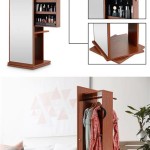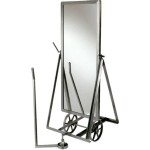Mirrors in Decorating
Mirrors offer significant versatility in interior design, serving both functional and aesthetic purposes. Their reflective qualities can dramatically alter the perception of space, light, and style within a room. Understanding the strategic placement and selection of mirrors can elevate a decorating scheme from ordinary to extraordinary.
One of the primary benefits of incorporating mirrors into a room is their ability to enhance natural light. Positioning a mirror opposite or adjacent to a window can effectively amplify available daylight, brightening the space and creating a more welcoming atmosphere. This is particularly advantageous in smaller rooms or spaces with limited natural light sources.
Mirrors can also create an illusion of spaciousness. Strategically placed mirrors can visually expand a room, making it appear larger than its actual dimensions. Placing a large mirror on a wall, for example, can double the perceived depth of a room, adding a sense of airiness and openness. This is a valuable tool in compact apartments or narrow hallways.
Beyond their practical uses, mirrors contribute significantly to a room's aesthetic appeal. They can serve as decorative focal points, adding an element of elegance and sophistication. Ornate frames, unique shapes, and antique mirrors can enhance the overall style and visual interest of a space. A well-chosen mirror can complement existing furniture and décor, contributing to a cohesive design.
The style of a mirror’s frame plays a crucial role in its integration within a room’s design. A simple, minimalist frame can suit a modern or contemporary aesthetic, while a more ornate, gilded frame complements traditional or classical interiors. Selecting a frame that harmonizes with the overall design scheme ensures the mirror enhances the room’s style rather than clashing with it.
The size and shape of a mirror should be carefully considered in relation to the surrounding space. A large, statement mirror can create a dramatic focal point in a living room or dining area. Smaller mirrors can be grouped together to create a gallery wall, adding visual interest and texture. The shape of the mirror, whether round, rectangular, oval, or a more unconventional form, also contributes to its decorative impact.
The placement of a mirror requires thoughtful consideration. Hanging a mirror too high or too low can disrupt the balance of a room. Ideally, the center of the mirror should be at eye level for optimal viewing. Positioning a mirror opposite a visually appealing element, such as a piece of artwork or a well-maintained garden view, can further enhance the room's aesthetic.
Mirrors can be incorporated into various rooms throughout the home, each serving a specific purpose. In a hallway, a long, narrow mirror can create the illusion of length and provide a practical space for last-minute appearance checks. In a bedroom, a full-length mirror is essential for dressing, while smaller decorative mirrors can add a touch of elegance to a vanity or dresser.
In bathrooms, mirrors are a functional necessity. A well-lit mirror above the vanity is crucial for grooming tasks. Consider incorporating additional mirrors to enhance the light and create a sense of spaciousness in smaller bathrooms. Mirrored cabinet doors can also add practical storage while contributing to the illusion of increased space.
When using mirrors in decorating, it's essential to avoid overdoing it. Too many mirrors in a single room can create a distracting and disorienting effect. A careful and balanced approach ensures that mirrors enhance the space without overwhelming it.
Cleaning and maintaining mirrors is essential to preserve their reflective qualities and overall aesthetic appeal. Regularly cleaning mirrors with a suitable glass cleaner prevents streaks and smudges, ensuring they continue to brighten and enhance the space. Addressing any chips or damage promptly helps maintain their functionality and aesthetic value.
Exploring different types of mirrors, such as antique mirrors, tinted mirrors, or those with decorative etching, can add a unique and personalized touch to a room. These specialized mirrors can serve as conversation pieces and contribute to a distinct design aesthetic. Choosing a mirror that reflects individual style and complements the overall décor can elevate a room from ordinary to extraordinary.
The use of mirrors in interior design offers a range of possibilities. From enhancing natural light and creating illusions of space to serving as decorative focal points, mirrors provide a versatile tool for transforming any room. Careful consideration of size, shape, frame style, and placement ensures that these reflective surfaces contribute to a cohesive and aesthetically pleasing environment.

25 Creative Ideas For Decorating With Mirrors

How To Decorate With Mirrors Ideas Advice Lamps Plus

Mirror Décor Ideas How To Decorate With Mirrors

10 Ideas For Decorating With Mirrors Stance Studies On The Family Living Room Decor

How To Decorate With Mirrors Decorating Ideas For

Decorating With Custom Mirrors
:max_bytes(150000):strip_icc()/118914680_348088313225832_6514047279381283704_n-dce6c6f4f04146bfba4837327d48fcd5.jpg?strip=all)
Expert Tips For Decorating With Mirrors

Mirror Decoration For Home 15 Ideas To Decorate With Mirrors

Mirror Decoration For Home 15 Ideas To Decorate With Mirrors

5 Decorating Ideas With Mirrors Advice Lamps Plus








